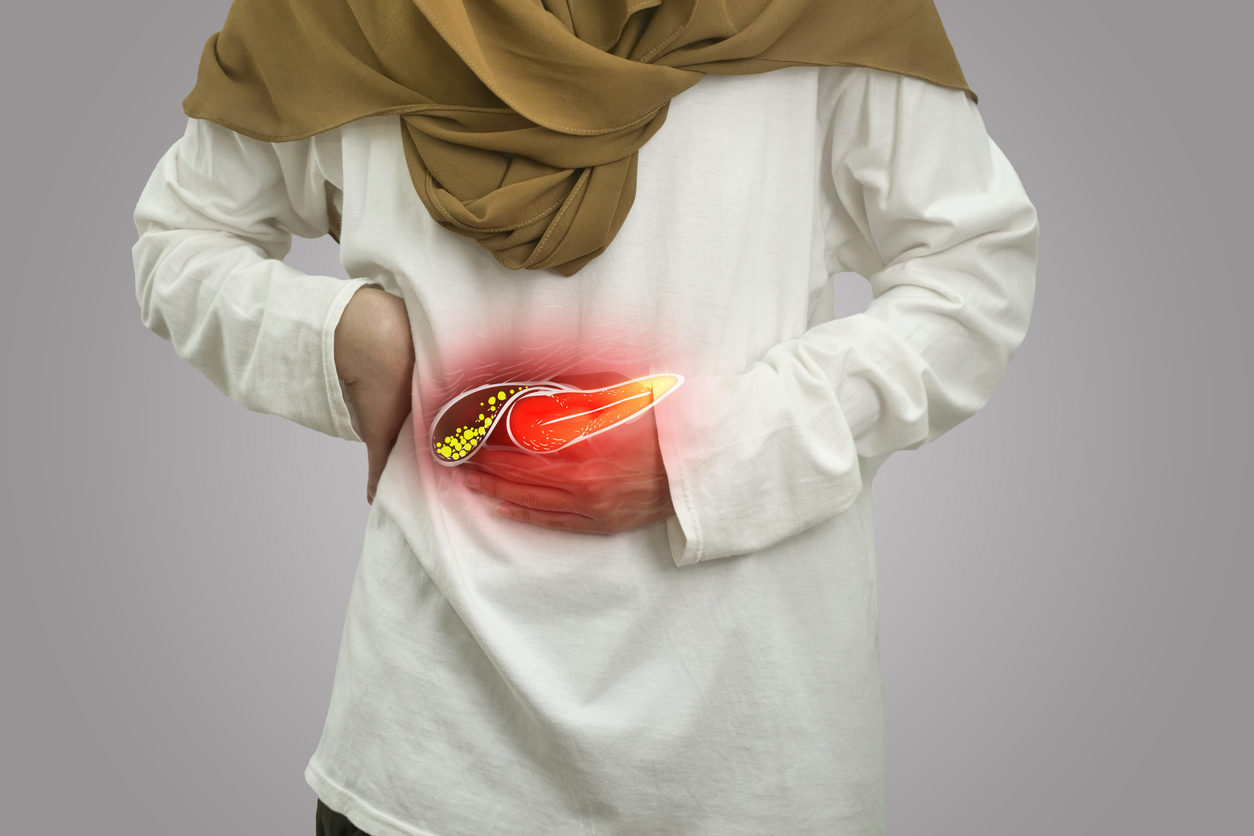2025-09-30
Gallstones: Genetics strikes back!
Gastroenterology and Hepatology
By Ana Espino | Published on september 30, 2025 | 3 min read
#GallstoneDisease #GeneticLoci #GeneticVariants
Gallstone disease, or cholelithiasis, is an extremely common digestive condition, affecting up to 25% of adults in some populations. Although often asymptomatic, it can lead to serious complications such as acute cholecystitis, biliary pancreatitis, or chronic debilitating pain. While metabolic and environmental factors (obesity, diet, sedentary lifestyle) are well-established contributors, our understanding of genetic factors remains incomplete—despite heritability being estimated at nearly 50%.
Faced with this reality, a major current challenge is the identification of new genetic loci associated with gallstone disease. The goal? To better understand the underlying biological mechanisms and uncover potential therapeutic targets to prevent or treat this common but often overlooked condition in public health strategies.
This is the context in which this study was conducted: to identify new variants associated with gallstone disease, analyze their biological functions, and extract potential therapeutic leads.
Over 750,000 individuals, including 69,000 confirmed cases of gallstone disease, were included in the study. The analysis identified 75 loci associated with gallstone disease—46 of which were novel and had never been reported before. These loci are involved in major biological pathways, notably cholesterol metabolism, hepatic bile acid transport, and gallbladder motility.
Among the newly associated genes, several present direct therapeutic interest—especially ANO1, TMEM147, and SLC10A2, which are known for their roles in digestive function and are already being explored as pharmacological targets in other diseases. Other genes like ABCG8, GCKR, UGT1A1, CYP7A1, and GPBAR1 play key roles in cholesterol metabolism, bile acid synthesis, or intestinal regulation, confirming their involvement in gallstone pathophysiology. The high expression of these genes in hepatocytes, enterocytes, and smooth muscle cells reinforces the idea that gallstone disease results from a combined imbalance of hepatic, digestive, and motility-related functions.
Despite being a common digestive disease with a significant clinical burden, gallstone disease remains poorly understood from a genetic standpoint. The main challenges lie in identifying relevant genetic loci, understanding the underlying molecular mechanisms, and translating these insights into therapeutic strategies—especially in a context where preventive options are virtually nonexistent.
This study aimed to map the genetic architecture of the disease at a genome-wide scale, integrating multi-cohort data to identify robust variants associated with gallstone formation. The results expand the known genetic repertoire, with 46 new loci identified, and highlight potentially actionable gene targets. This opens the door to a molecular reclassification of gallstone disease and a targeted prevention strategy—which currently does not exist.
Further research will help validate the candidate genes functionally, explore their mechanisms of action, and develop risk biomarkers for early screening. It will also pave the way for designing targeted therapies based on the identified biological pathways—moving toward predictive, preventive, and personalized medicine applied to biliary diseases.
About the author – Ana Espino
As a scientific writer, Ana is passionate about bridging the gap between research and real-world impact. With expertise in immunology, virology, oncology, and clinical studies, she makes complex science clear and accessible. Her mission: to accelerate knowledge sharing and empower evidence-based decisions through impactful communication.
#GallstoneDisease #GeneticLoci #GeneticVariants
Gallstone disease, or cholelithiasis, is an extremely common digestive condition, affecting up to 25% of adults in some populations. Although often asymptomatic, it can lead to serious complications such as acute cholecystitis, biliary pancreatitis, or chronic debilitating pain. While metabolic and environmental factors (obesity, diet, sedentary lifestyle) are well-established contributors, our understanding of genetic factors remains incomplete—despite heritability being estimated at nearly 50%.
Faced with this reality, a major current challenge is the identification of new genetic loci associated with gallstone disease. The goal? To better understand the underlying biological mechanisms and uncover potential therapeutic targets to prevent or treat this common but often overlooked condition in public health strategies.
This is the context in which this study was conducted: to identify new variants associated with gallstone disease, analyze their biological functions, and extract potential therapeutic leads.
What if our genes were forming stones?
Over 750,000 individuals, including 69,000 confirmed cases of gallstone disease, were included in the study. The analysis identified 75 loci associated with gallstone disease—46 of which were novel and had never been reported before. These loci are involved in major biological pathways, notably cholesterol metabolism, hepatic bile acid transport, and gallbladder motility.
Among the newly associated genes, several present direct therapeutic interest—especially ANO1, TMEM147, and SLC10A2, which are known for their roles in digestive function and are already being explored as pharmacological targets in other diseases. Other genes like ABCG8, GCKR, UGT1A1, CYP7A1, and GPBAR1 play key roles in cholesterol metabolism, bile acid synthesis, or intestinal regulation, confirming their involvement in gallstone pathophysiology. The high expression of these genes in hepatocytes, enterocytes, and smooth muscle cells reinforces the idea that gallstone disease results from a combined imbalance of hepatic, digestive, and motility-related functions.
Towards a genomics of the gallbladder?
Despite being a common digestive disease with a significant clinical burden, gallstone disease remains poorly understood from a genetic standpoint. The main challenges lie in identifying relevant genetic loci, understanding the underlying molecular mechanisms, and translating these insights into therapeutic strategies—especially in a context where preventive options are virtually nonexistent.
This study aimed to map the genetic architecture of the disease at a genome-wide scale, integrating multi-cohort data to identify robust variants associated with gallstone formation. The results expand the known genetic repertoire, with 46 new loci identified, and highlight potentially actionable gene targets. This opens the door to a molecular reclassification of gallstone disease and a targeted prevention strategy—which currently does not exist.
Further research will help validate the candidate genes functionally, explore their mechanisms of action, and develop risk biomarkers for early screening. It will also pave the way for designing targeted therapies based on the identified biological pathways—moving toward predictive, preventive, and personalized medicine applied to biliary diseases.
Read next: The silent face of autoimmune liver diseases
About the author – Ana Espino
PhD in Immunology, specialized in Virology

Last press reviews
Could cinnamon become a natural treatment for metabolic syndrome?

By Lila Rouland | Published on December 5, 2025 | 3 min read<br><br>...
Who is afraid of Christmas? Do holidays trigger psychiatric crises?

By Carolina Lima | Published on Décember 4, 2025 | 3 min read
Twice-yearly injections to change the game?

By Ana Espino | Published on December 3rd, 2025 | 3 min read